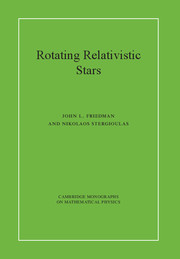Book contents
- Frontmatter
- Dedication
- Contents
- Preface
- List of symbols
- Conventions, notation, and mathematical preliminaries
- 1 Stationary, axisymmetric equilibria
- 2 3+1 split, action, Lagrangian, and Hamiltonian formalisms
- 3 Asymptotics, virial identities, and nonaxisymmetric equilibria
- 4 Numerical schemes
- 5 Equilibrium models
- 6 Approximation methods for equilibria
- 7 Perturbation theory of relativistic fluids
- 8 Quasinormal modes
- 9 Stellar stability
- 10 Nonlinear dynamics of rotating relativistic stars
- Appendix A Lie derivatives, forms, densities, and integration
- Appendix B The Newtonian limit of the two-potential formalism
- Bibliography
- Index
9 - Stellar stability
Published online by Cambridge University Press: 05 July 2013
- Frontmatter
- Dedication
- Contents
- Preface
- List of symbols
- Conventions, notation, and mathematical preliminaries
- 1 Stationary, axisymmetric equilibria
- 2 3+1 split, action, Lagrangian, and Hamiltonian formalisms
- 3 Asymptotics, virial identities, and nonaxisymmetric equilibria
- 4 Numerical schemes
- 5 Equilibrium models
- 6 Approximation methods for equilibria
- 7 Perturbation theory of relativistic fluids
- 8 Quasinormal modes
- 9 Stellar stability
- 10 Nonlinear dynamics of rotating relativistic stars
- Appendix A Lie derivatives, forms, densities, and integration
- Appendix B The Newtonian limit of the two-potential formalism
- Bibliography
- Index
Summary
Introduction
Neutron stars more than a few minutes old are uniformly rotating and satisfy to high accuracy the equation of state that describes cold neutron-star matter. As described in Chapter 5, their 2-dimensional family of equilibria is bounded by four curves: at low central density by a sequence of marginally stable configurations having minimum mass at constant angular momentum; at high density by a sequence of marginally stable configurations having maximum mass at constant angular momentum; by the sequence of nonrotating stars; and by the sequence of stars rotating at the Kepler (mass-shedding) limit on angular velocity. A nonaxisym-metric instability driven by gravitational radiation (the CFS instability) is likely to set an upper limit on rotation more stringent than the Kepler limit, drawing a more restrictive boundary at large rotation on the surface of stable equilibria.
Finding these bounding lines of marginal stability is a primary focus of work on the stability theory of relativistic stars. This chapter is devoted to a detailed presentation of this theory and several of its principal results. The presentation here is restricted to linear stability theory, to finding criteria for stability of first-order perturbations of an equilibrium. Numerical treatments of the nonlinear evolution of stable and unstable modes are discussed in Chapter 10.
- Type
- Chapter
- Information
- Rotating Relativistic Stars , pp. 250 - 303Publisher: Cambridge University PressPrint publication year: 2013



